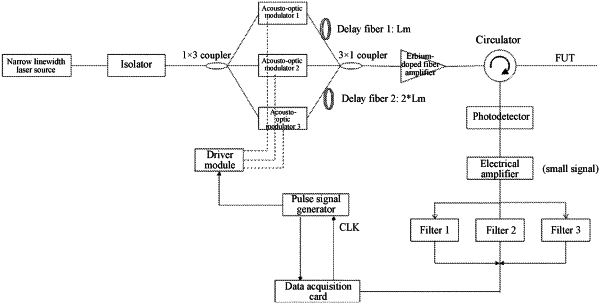| CPC G01D 5/35358 (2013.01) | 9 Claims |

|
1. A self-heterodyne phase-sensitive optical time domain reflectometry (φ-OTDR) system with a free multi-spatial resolution, wherein the φ-OTDR system comprises a narrow linewidth laser source, a 1×3 fiber-optic coupler, three acousto-optic modulators (AGMs), a 3×1 fiber-optic coupler, two time-delay fibers, an erbium-doped fiber amplifier (EDFA), a circulator, a photodetector, an electrical amplifier, three filters, a data acquisition card, a pulse signal generator, and a driver module, wherein
the narrow linewidth laser source is configured to generate a continuous laser with a high coherence characteristic and inject the continuous laser into a fiber;
the 1×3 fiber-optic coupler is provided with an input terminal connected to the narrow linewidth laser source through an isolator and three output terminals respectively connected to the three AOMs, and the 1×3 fiber-optic coupler is configured to divide the continuous laser generated by the narrow linewidth laser source into three paths of light with equal powers, and the three paths of light are modulated by the three AOMs into three paths of probe light with different frequency shifts;
the 3×1 fiber-optic coupler comprises first to third input terminals, the three AOMs are first to third AOMs, wherein the first input terminal and the second input terminal are respectively connected to output terminals of the first and second AOMs through the two time-delay fibers, the third input terminal is directly connected to an output terminal of the third AOM, and the 3×1 fiber-optic coupler further comprises an output terminal connected to an input terminal of the circulator through the EDFA; the three paths of probe light are coupled into the EDFA through the 3×1 fiber-optic coupler for amplification and then enters the circulator; and a first output terminal of the circulator is connected to the photodetector and a second output terminal of the circulator is connected to a to-be-detected fiber;
the photodetector is connected to the three filters with different center frequencies through the electrical amplifier, and the photodetector is configured to convert one path of an optical signal output by the circulator into an electrical signal, wherein the electrical signal is amplified by the electrical amplifier and then enters the three filters for bandpass filtering for generating first to third groups of intermediate frequency signals; a difference between arm lengths of the two time-delay fibers is controlled to enable the first and second groups of intermediate frequency signals to have a same spatial resolution, and the third group of intermediate frequency signals to have a different spatial resolution from the first and second groups of intermediate frequency signals; and a spatial resolution is determined by a pulse interval and a pulse width of an intermediate frequency signal;
the data acquisition card is connected to the driver module through the pulse signal generator, and an output terminal of the driver module is simultaneously connected to the three AOMs; and the data acquisition card is configured to sample the three groups of intermediate frequency signals to obtain original signals, and the pulse signal generator generates a corresponding modulation signal according to the original signals obtained through sampling and sends the modulation signal to the driver module, and the driver module simultaneously controls the three AOMs to generate a corresponding pulse probe light;
in the φ-OTDR system, the first and second groups of intermediate frequency signals with the same spatial resolution are used to avoid a coherent fading area based on an optimization algorithm through frequency division multiplexing to restore the original signals; and
a process of avoiding the coherent fading area based on the optimization algorithm through frequency division multiplexing to restore the original signals comprises:
when a monophonic vibration signal is applied to the to-be-detected fiber under an external disturbance, demodulating the original signals at a computer side and then comparing demodulation results of the first and second groups of intermediate frequency signals with the same spatial resolution to obtain a distortion of two demodulated original signals in different positions caused by a coherent fading; and during a restoration, actively avoiding positions with the distortion to restore the original signals and suppress coherent fading noise.
|